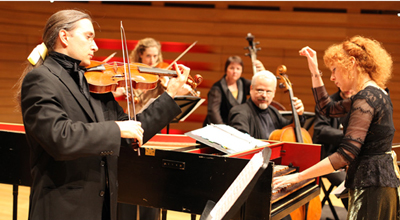by Daniel Hathaway

That, of course, largely involved Antonio Vivaldi, the “red priest” and author of some 500 concertos, whose all-female orchestra at the Pio Ospedale della Pietà gave concerts every Sunday and apparently chewed through a lot of material. Apollo’s Fire included only three Vivaldi concerti on its program on Friday, but they suggested the wide range of the composer’s invention and underlined the reasons for his popularity then and now.
Bassoonist Marc Vallon lent his warm, expressive tones to Vivaldi’s solo lines in the a-minor concerto (RV 497), with a slow movement lifted from another concerto in the same key (RV 498). Bouncy and lyrical passages vied for supremacy in the opening Allegro along with surprising pauses. Vallon played the fetching melody of the borrowed Larghetto with poignancy, and tucked a cascading cadenza into the final movement.
Violinists Julie Andrijeski and Johanna Novom splendidly took the solo honors in Vivaldi’s g-minor concerto, RV 578, beginning with sneaky entrances that led to stabbing gestures of surprising violence, and repetitive figures that Philip Glass might admire. Throughout, the violinists traded not only musical motifs but meaningful facial expressions as well. A cheerful pastoral Allegro in 12/8 gave the soloists further material to smile over.
The concert ended with an all-out Concerto in F per molti strumenti (RV 569) that involved the whole band, including delightfully raucous horns (Todd Williams and Sara Cyrus), intricate fiddling (Olivier Brault), chattering oboes (Debra Nagy and Luke Conklin), and a jaunty bassoon (Marc Vallon). A profusion of styles under one musical roof made for delightful contrasts. Eventful dialogues between Brault and cellist René Schiffer, a Siciliana (in the Adagio) for upper strings alone, and some arresting chord progressions near the end stood as testaments to Vivaldi’s restless imagination. Sorrell mentioned beforehand that parts of RV 569 sounded like Handel, providing the launching pad for a cute interchange between horn (playing a line from Water Music) and violin (playing a phrase from The Four Seasons).
Besides Vivaldi, the program also visited works by Marco Uccellini, Pietro Locatelli, and Evaristo Dall’Abaco, non-Venetians all, but who either grew up close to the Most Serene Republic or did some work there.
Only two movements of Locatelli’s Concerto Grosso in c, Op. 1, No. 11 were offered on Friday, a Largo and a Giga allegro, but more would have been welcome. Apollo’s Fire played the slow movement rather fussily, but the echoes and strange pauses in the gigue were delightful.
Dall’Abaco’s Concerto in e per più strumenti, Op. 5, No. 3 was full of nervous energy if not timeless music. Featuring alluring performances by Kathie Stewart, traverso, and Debra Nagy, oboe, its most memorable moments came in the Passepieds or finale, where a catchy tune was put through both major and minor hoops.
The concert opened with Sorrell’s “Concerto Grosso” arrangement of a movement from Uccellini’s Trio Sonata in D, renamed La Bergamasca. A set of extravagant variations on a four-note bass line, the piece showed Apollo’s Fire at its exuberant best, engaging with the music as few early music ensembles dare to do. Picture the cellists, bassist, and continuo players cherishing those endlessly repeating four notes as though they were the finest bass line ever written, and you can see why Apollo’s Fire charmed audiences from Tanglewood to England to Italy last summer — and did it once again on Friday night in Cleveland Heights.
Published on ClevelandClassical.com October 19, 2015.
Click here for a printable copy of this article



